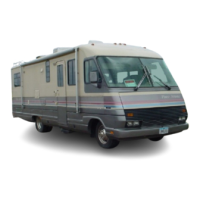USING LP GAS SYSTEM
AT
LOW TEMPERATURES
Your LP gas system will function at low temper-
atures, provided the system components are kept
at a temperature above the vapor point
of
the LP
gas. Ask your LP gas supplier or your motor
home dealer for information on product blends
available in your area and the areas in which
you will be traveling.
The following chart shows the reduction in
available BTU's/hour under various fill levels
as
the temperature drops:
20LB.TANK*
% FULL
+20·
O·
·5·
·10·
·15·
60% 36,000 18.000 12,750 8,500 4,250
50% 32,400 16,200 12,150 8,100 4,050
40% 28,800 14,400 11,400 7,600 3,800
30% 25,200 12,600 10,450 7,300 3,150
20% 21,600 10,800 8,100 5,400 2,700
10% 16,200 8,100 6,075 4,050 2,025
*30
lb. Tank multiply x 1.40
The chart clearly shows how the availability
of
the gas
is
reduced at lower temperatures. With
this
in
mind, keep your LP gas tank
as
full
as
possible during cold weather. Check the BTU/hr
rating plates on your
LP gas appliances. This info-
lmation will help you manage your LP gas usage.
FILLING LP GAS TANKS
To fill the chassis-mounted storage tank, drive
the vehicle to an
LP gas supplier or a service
station which sells
LP gas. Do not attempt to fill
the
LP gas tank yourself.
A.
WARNING
Turn off LP gas main valve before filling
LP
gas tank
or entering
an
LP
gas bulk plant or motor fuel service
station. Turn off all pilot lights and appliances
individ·
ually before refueling of motor fuel tanks and/or
LP
gas containers. When not individually turned off, auto·
matic ignition appliances may continue to spark when
LP gas is turned off at the container.
LP
Gas
System
LP GAS SYSTEM CHECK
Do a visual check
of
all exposed piping and fit-
tings after you have arrived at a destination and
before you use the
LP gas system.
Keep the tank valve closed and turn off all
appliances
if
the unit
is
not being used.
Always have the system checked by a
profes-
sional any time you detect a garliclrotten egg
like odor or hear a sustained hiss when you turn
the LP gas on.
A.
WARNING
Never check for leaks with
an
open flame. Do not
check copper and brass plumbing lines and fittings for
leaks using ammoniated or chlorinated household
type detergents. These can cause cracks to form
on
the line and brass fittings. If the leak cannot be located,
take the unit to an
LP
gas service representative.
LP GAS LEAK DETECTOR/ALARM
A permanently installed LP gas leak detector/
alarm
is
located near the floor. The unit contains
an alarm that will sound alerting you to the
presence
of
low levels
of
potentially dangerous
LP gas that may have accumulated.
The detector/alarm unit
is
powered by the 12-
volt DC system in your motor home. A green
light on the detector/alarm front panel indicates
that the detector/alarm has power.
Test the leak detector/alarm each time the motor
home is relocated and set up for use. Detailed
information for the leak detector/alarm can be
found in the
Owner's Information Package.
Testing Procedure:
1.
Hold a butane-fueled pocket lighter near
the sensor.
2.
Open the lighter valve without striking the
flame.
3. The leak detector/alarm should respond
within a few seconds.
4.
Press the silence button to reset the alarm.
09-3
1---

